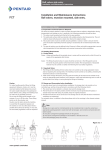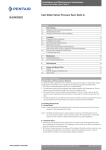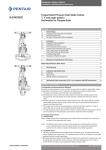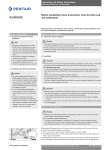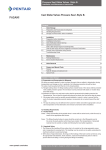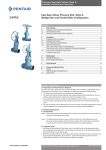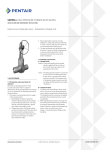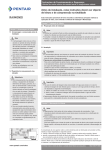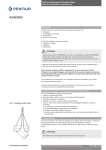Download Raimondi Ball Valves, Figure 5600
Transcript
Ball valves fully welded Installation and Maintenance Instructions RAIMONDI Rating and temperature limits Pressure rating: ANSI Class 150 to Class 900 Temperature range :-46°C to +150°C (if standard design); +200°C (if modification material seat insert) Check the information in the marking plates placed on the valves. Installation and Maintenance Instructions Ball valves, fully welded 1. Marking To ensure a correct use of our products, check the information on the CE, and ATEX (if any) marking plate, fixed on the valve. Information on the standard CE marking plate: Type Type of valve Class Pressure class NPS/DN Diameter in inches/mm Fab. Y/M Manufacturing date Body Body material Seat Seat material Obturator Obturator material Stem Stem material Seal Seal material End to end End to end length Pmax / T min Max pressure at Min temp Fire safe Fire Safe Pmax / T max Max pressure at Max temp NACE Complies with NACE PED Categ. PED category FluidFluid Shell test press. Shell test pressure Double B.&B. Double Block and bleed PO/N° N° order TAG Valve reference number Double P. Double piston effect Self Rel. Single piston effect S/N° Serie number Information on the standard ATEX marking plate Ex Specific mark II Group II 2 Category 2 G Can be used in gas athmosphere D Can be used in dust athmosphere c Ignition protection category TR_ATEX_01 Identification number X See instruction manual for information Can be used for zone 1, 21 and 2, 22 www.pentair.com/valves Pentair reserves the right to change the contents without notice RAILT-0042-EN-1305 Ball valves fully welded Installation and Maintenance Instructions Section 2 - Valve Storage 2.1 Preparation and Preservation for Shipment All valves are properly packed in order to protect the parts that are subject to deterioration during transportation and storage on site. In particular, the following precautions should be taken: 1. The valves must be packed with the ball in the open position. 2. The weld ends surface shall be protected with suitable protective like Deoxaluminite. The end shall be closed with plywood or plastic disc fixed at the edge by straps. 3. All actuated valves must be carefully securely palleted or crated, in order to ensure that the parts of actuator (especially pneumatic piping or accessories) do not extend beyond the skid/ crate. 4. The type of packing must be defined in the Customer’s Order and shall be appropriate to ensure safe transportation to final destination and eventual conservation before installation. 2.2 Handling Requirements A - Packed Valves Crates: Lifting and handling of the packed valves in crates will be carried out by a fork lift truck, by means of the appropriate fork hitches. Cases: The lifting of packed valves in cases should be carried out in the lifting points and at the center of gravity position which have been marked. The transportation of all packed material must be carried out safely and following the local safety regulations. B - Unpacked Valves 1. The lifting and the handling of these valves has to be carried out by using appropriate means and by respecting the carrying limits. The handling must be carried out on pallets, protecting the machined surfaces to avoid any damage. 2. With valves of large dimensions, the sling and the hooking of the load must be carried out by using the appropriate tools (brackets, hook, fasteners, ropes) and load balancing tools in order to prevent them from falling or moving during the lifting and handling. 2.3 Storage and Preservation before Installation In case the valves have to be stored before installation, the storage has to be carried out in a controlled way, and has to be performed in accordance with the following criteria: 1. The valves have to be stocked in a closed, clean and dry storage room. 2.The ball must be in the open position and the end faces must be protected with plastic or wooden discs fixed with straps. If possible, keep the original protection. 3.Periodical checks have to be carried out in the storage area to verify that the above mentioned conditions are maintained. For actuated valves, in addition to the above please refer to the warnings in the relevant actuator manual. Note Storage in an open area for a limited period can be considered only in case the valves have appropriate packing (packed in cases lined with tarred paper, and contents well protected with barrier sacks). Do not place consignment packages directly on the ground. Do not expose consignment packages to the weather or directly to the sun. Check the packaging every two months. Figure no. 1 Pentair reserves the right to change the contents without notice page 2 Caution For valve handling and/or lifting, the lifting equipment (fasteners, hooks, etc.) must be sized and selected while taking into account the valve weight indicated in the packing list and/or delivery note. Lifting and handling must be made only by qualified personnel. Do not use the lifting points located on the actuator, if any, to lift the valve. These lifting points are for the actuator only. Caution must be taken during the handling to avoid that this equipment passes over the workers or over any other place where a possible fall could cause damage. In any case, the local safety regulations must be respected. Ball valves fully welded Installation and Maintenance Instructions Section 3 - Installation 3.1 Preparation before installation 1. Carefully remove the valve from the shipping package (box or pallet) avoiding any damage to the valve or, in case of automated valves, to the electric or pneumatic/hydraulic actuator or instrumentation. 2.Clean the inside of the valve using an air line. Ensure that there are no solid objects such as pieces of wood, plastic or packing materials within the valve or on the valve seat. 3.Confirm that the materials of construction listed on the valve nameplates (service and temperature) are appropriate for the service intended and are as specified. 4.Define the preferred mounting orientation with respect to the system pressure. If any (see arrow on the body), identify the upstream side (high pressure) and downstream side (low pressure). Warning • Verify that the direction of the flow in the line corresponds to the arrow indicated on the valve body. Valves without the arrow are bi-directional. • See the actuator user manual for the actuator preparation. • Verify the assembly of the overpressure relief device in case of liquid service and double piston effect option. 3.2 Installation Instructions Ball valves are normally installed in horizontal pipe with vertical stem. These valves can also be installed with no limitation regarding the pipe or stem orientation. However, in this case the actual pipe/stem orientation should be advised to allow for the right position of the drain plug. Unless otherwise recommended by the manufacturing plant, the valve should be installed with the ball in the open position, to ensure that the seat rings are not damaged during installation. Particular care should be taken with those valves equipped with ‘fail-close’ actuators. For operating temperatures above 200°C (392°F) thermal insulation of the valve body is recommended. Handling and lifting of the valves during installation MUST be performed following the same criteria and instructions described in previous points “2.2 Handling Requirements” and “2.3 Storage and Preservation before Installation”. Buttweld Valves Position the valve and check the alignment with the pipe. Proceed with welding, in accordance with the applicable welding procedure. Important It is recommended to perform piping flushing before installation of the valve. If this is not possible, the valve must be set with the ball in full open position before starting with flushing. For buttweld end valves: To avoid any damage to the gaskets, the temperature during the pipe welding and the heat treatment has to be monitored by a thermocouple placed in the seat grease injector holes. Make sure to limit the temperature at maximum of 200°C. This instruction has to be carefully followed especially in case there are not any transition piece (pup piece) welded to the valve. 3.3 Valve Verification Before Start Up 1. Verify the tightness of the drain plug and of the vent valve. 2.Check the valve operability by stroking it to “full open” and “full close”. Important If piping system is pressurized with water for testing, and in case the piping system has been shut down after testing for a long time, the following recommendations should be adopted: a.Use corrosion inhibitor with water to pressurize the piping system b.After testing, the piping system should be depressurized and the test water completely drained. Pentair reserves the right to change the contents without notice page 3 Ball valves fully welded Installation and Maintenance Instructions 3.4 Operations Instructions 1. Make sure to perform periodic valve verification as described in paragraph 3.5. 2.In case of actuated valves always follow the specific instructions given by the actuator’s manufacturer. 3.Never change the setting of torque and/or limit switches which have been carefully set during the final test at our workshop. 4.Never change the setting of the mechanical stops of the gearbox. 3.5 Periodic Valve Verification During Service A - Normal Check 1. Verify monthly that there is no leakage from the gaskets or through the seats. If the leakage has been detected in the stem/bonnet area, inject the proper seal as it grease through the stem grease injector. Use the seat injectors device to stop the leakage of the valve in close position. The sealant injection is to be considered as an emergency operation to stop the leakage up to the next planned maintenance job. If the leakage does not stop, follow the maintenance procedure for the replacement of the gaskets in Section 4. 2.For actuated valves, in addition to the above, please refer also to the warnings in the actuator manual. B - Preventive Actions 1. Every 3 months verify the tightness of bolts, drain, vent. 2.For the actuator, proceed as indicated in its maintenance manual. 3.6 Troubleshooting Guide Symptom Possible Cause Solution Stem gasket leaking 1. Gasket damage 1. Sealant injection (temporary) 2. Gasket replacement (see section 4) Body-bonnet gasket leaking 1. Gasket damage 1. Gasket replacement (see section 4) Valve leaking 1. Valve not fully closed 2. Debris trapped in valve 3. Sealing surface damaged* 1. Close the valve 2. Cycle and flush (with valve open) to remove debris 3. Perform sealant injection. 1. Not enough feed pressure 1. Increase the actuator feed pressure. Jerky operation * Check seat sealing by: - Opening the vent valve - Opening or closing completely the ball and with pressure in the line Check that after a while there is not any more pressure coming out from the vent valve. Pentair reserves the right to change the contents without notice page 4 Ball valves fully welded Installation and Maintenance Instructions Bolted bonnet style Section 4 - Maintenance This section describes on site repairs as: - Stem/Bonnet Gasket replacement All the other repairs (major repairs) should be performed by the manufacturing plant or Nominated Service Company. 4.1. Stem/Bonnet Gasket Replacement Please refer to figures no. 2 and 2A for bolted bonnet style, and no. 3 and 3A for welded bonnet style. Note: The following instructions are applicable to a fully welded valve completed with extension. If the valve is supplied without any extension, the related references are not applicable. Warning Figure no. 2 Before starting any maintenance operations, check that the vent valve is open. The ball must be completely in open or close position with no pressure in the body cavity. Failure to do so may cause serious personal injury and/or equipment damage. 1. Place the valve in fully open or fully closed position. 2. Open the vent and discharge the pressure. The vent valve has to be in open position during all operations. 3. Remove the operator from the top flange of the extension (if any). 4. Remove the coupling bushing to disassemble the stem-actuator from the stem-extension (if any) 5. Sling the extension (if any). 6. Remove the bottom flange of the extension (if any). 7. Lift the extension using the proper lifting lugs. 8. Remove the coupling flange (pos. 11) by means of the bolts (pos. 14) using the extraction holes. 9. Remove the lantern ring (pos. 48) using the extraction holes. 10. Only for fig. 2 and 2A: remove the bonnet (pos. 12) by means of the bolts or screws (pos. 14), using the extraction holes. 11. Only for fig. 2 and 2A: remove the lip seal gasket (pos. 13b). Make sure not to damage the sealing surfaces on the stem and body. 12. Carefully clean all the sealing surfaces using proper remover products. Visually check all the sealing surfaces: if damaged, they should be repaired. Only for fig. 2 and 2A: for lip-seal assembling use the conical ring special tool. 13. Change the damaged gaskets and reassemble all parts following backwards the above mentioned steps. 14. Close the vent valve. Figure no. 2A Warning The stem has been designed as ‘antiblow out’ to improve safety during the service. This means that the stem cannot be disassembled. Welded bonnet style Figure no. 3 Pentair reserves the right to change the contents without notice Figure no. 3A page 5 Ball valves fully welded Installation and Maintenance Instructions Section 5 - Valve Removal If the valve needs to be removed from the line for some extraordinary reason, the user should ensure the following: Warning Depressurize the line before starting any maintenance. Failure to do so may cause serious personal injury and/or damage to the valve. 1. The valve is depressurized; 2. The pipe shall be cut as far away from the valve as possible. Section 6 - Greases and Special Tools 6.1 Sealant Greases The suggested sealant grease is MOLYCOTE 111, valve lubricating and sealing silicone compound by DOW CORNING. 6.2 Special Tools The only suggested tool is the conical ring suitable for the gasket assembly. Pentair reserves the right to change the contents without notice page 6






